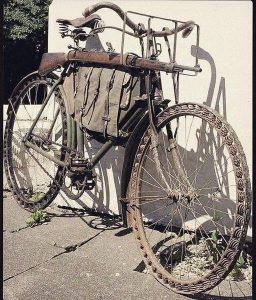Military bicycle with spring wheels from the 1900’s
Key Features of Military Bicycles from the Early 1900s
Spring Wheels:
Some military bicycles were equipped with spring wheels or suspension systems designed to absorb shocks, making them suitable for rough terrains.
This feature allowed for better comfort and stability, particularly in challenging environments.
Durability:
Military bicycles were built to withstand harsh conditions, often made with sturdy materials and reinforced frames.
They typically had wider tires for better traction and were sometimes fitted with fenders to protect riders from mud and debris.
Utility and Design:
These bicycles often had additional features like racks for carrying supplies, tools, or weapons.
Some models were designed to be collapsible or foldable, allowing for easy transport and storage.
Historical Context
Use in Military Campaigns:
Bicycles became increasingly popular during World War I, where they were used for quick troop movement, transporting messages, and scouting missions.
They allowed for greater mobility compared to traditional methods like marching or using horses, especially in areas with poor infrastructure.
Bicycle Corps:
Many armies, including those of the United States, Germany, and Britain, formed bicycle corps. These units specialized in using bicycles for various military operations.
Soldiers trained to ride in formation, and some units were even equipped with specialized bicycles for different terrains.
Notable Examples
The German Military Bicycle:
The German army produced bicycles that were robust and adapted for military use, including features like folding frames.
They were often used for communication and as a means of rapid movement during conflicts.
The U.S. Army’s Bicycle Corps:
In the late 19th and early 20th centuries, the U.S. Army experimented with bicycle units, particularly during the Spanish-American War and later.
The 25th Infantry Bicycle Corps famously rode from Missoula, Montana, to St. Louis, Missouri, in 1896 to demonstrate the utility of bicycles in military logistics.
Legacy
The use of bicycles in military operations laid the groundwork for modern military mobility concepts. While bicycles eventually gave way to motorized vehicles, their initial impact on warfare and logistics was significant. Today, bicycles are still used by some military forces for specific applications, especially in regions where motor vehicles are impractical.

Technical Innovations
Spring Suspension Systems:
The introduction of spring wheels aimed to improve ride comfort and handling on uneven terrain. These systems often involved coil springs integrated into the wheel or frame design.
Some bicycles featured a form of “cantilever” frame, which added strength while allowing for better shock absorption.
Cargo Capacity:
Military bicycles were designed with practicality in mind. Many included built-in racks and sometimes even panniers to carry additional gear, supplies, or weaponry.
Some models could even be outfitted with attachments for carrying heavier loads or specialized equipment.
Tire Design:
Wider, reinforced tires provided better grip and stability on various surfaces, which was crucial for off-road navigation.
Pneumatic tires were becoming more common, offering improved shock absorption and comfort compared to solid rubber tires.
Historical Use and Campaigns
World War I:
Bicycles played a crucial role in logistics and communication. They allowed soldiers to quickly transport messages between units, especially in areas where motor vehicles were less effective due to mud or destruction.
Some armies utilized bicycles for reconnaissance missions, allowing troops to scout enemy positions without attracting too much attention.
World War II:
Although motor vehicles became predominant, bicycles were still used in certain campaigns, especially in regions where fuel was scarce or terrain was challenging.
The German army famously used bicycles for rapid troop movement during the early phases of the war, particularly in the invasion of France.
Notable Units:
25th Infantry Bicycle Corps: This unit was formed in 1896 and conducted a notable cross-country ride to demonstrate the effectiveness of bicycles for military transport. They completed a 1,900-mile journey in just 40 days.
British Bicycle Corps: The British Army formed bicycle units during WWI, which were used for various roles, including as dispatch riders.
Cultural Impact
Public Perception:
Bicycles were seen as symbols of modernity and progress in the late 19th and early 20th centuries. Their use by military forces reflected broader societal changes regarding mobility and transportation.
The incorporation of bicycles into military logistics also illustrated a shift towards more mechanized and efficient forms of warfare.
Post-War Use:
After World War I, many soldiers returned home and continued to use bicycles for personal transportation, contributing to the growth of cycling as a popular recreational activity.
Bicycles remained a part of military training for many countries, emphasizing physical fitness and endurance.
Modern Relevance
Current Military Applications:
Today, some modern military units still use bicycles, particularly for special operations, where stealth and mobility are crucial.
Bicycles are sometimes employed in peacekeeping missions or in urban environments where quick, silent movement is necessary.
Sustainability:
As military forces worldwide become more aware of sustainability issues, bicycles present an environmentally friendly alternative for certain logistical operations.
They can also serve as an effective means of transportation in remote areas where traditional vehicles may struggle.
Conclusion
Military bicycles from the early 1900s represent a fascinating intersection of technology, mobility, and military strategy. Their evolution highlights how armies adapted to changing circumstances and technological advancements. The legacy of these bicycles continues to influence both military logistics and recreational cycling today. If you have any specific models, countries, or events you’d like to explore further, just let me know!






